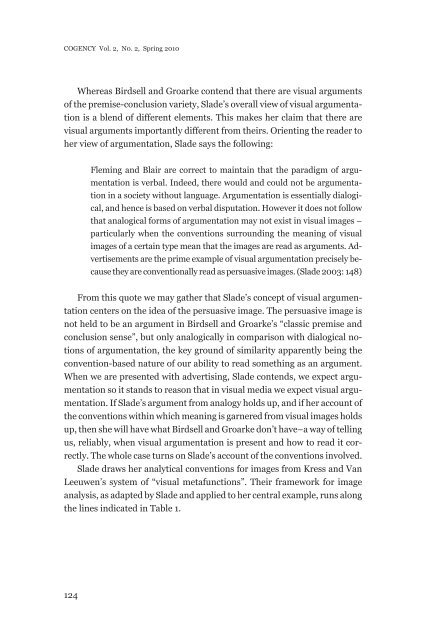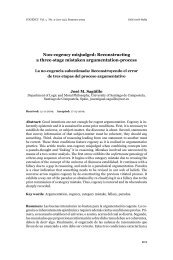Cogency v2 n2
Cogency v2 n2
Cogency v2 n2
You also want an ePaper? Increase the reach of your titles
YUMPU automatically turns print PDFs into web optimized ePapers that Google loves.
COGENCY Vol. 2, N0. 2, Spring 2010<br />
Whereas Birdsell and Groarke contend that there are visual arguments<br />
of the premise-conclusion variety, Slade’s overall view of visual argumentation<br />
is a blend of different elements. This makes her claim that there are<br />
visual arguments importantly different from theirs. Orienting the reader to<br />
her view of argumentation, Slade says the following:<br />
Fleming and Blair are correct to maintain that the paradigm of argumentation<br />
is verbal. Indeed, there would and could not be argumentation<br />
in a society without language. Argumentation is essentially dialogical,<br />
and hence is based on verbal disputation. However it does not follow<br />
that analogical forms of argumentation may not exist in visual images –<br />
particularly when the conventions surrounding the meaning of visual<br />
images of a certain type mean that the images are read as arguments. Advertisements<br />
are the prime example of visual argumentation precisely because<br />
they are conventionally read as persuasive images. (Slade 2003: 148)<br />
From this quote we may gather that Slade’s concept of visual argumentation<br />
centers on the idea of the persuasive image. The persuasive image is<br />
not held to be an argument in Birdsell and Groarke’s “classic premise and<br />
conclusion sense”, but only analogically in comparison with dialogical notions<br />
of argumentation, the key ground of similarity apparently being the<br />
convention-based nature of our ability to read something as an argument.<br />
When we are presented with advertising, Slade contends, we expect argumentation<br />
so it stands to reason that in visual media we expect visual argumentation.<br />
If Slade’s argument from analogy holds up, and if her account of<br />
the conventions within which meaning is garnered from visual images holds<br />
up, then she will have what Birdsell and Groarke don’t have–a way of telling<br />
us, reliably, when visual argumentation is present and how to read it correctly.<br />
The whole case turns on Slade’s account of the conventions involved.<br />
Slade draws her analytical conventions for images from Kress and Van<br />
Leeuwen’s system of “visual metafunctions”. Their framework for image<br />
analysis, as adapted by Slade and applied to her central example, runs along<br />
the lines indicated in Table 1.<br />
124








